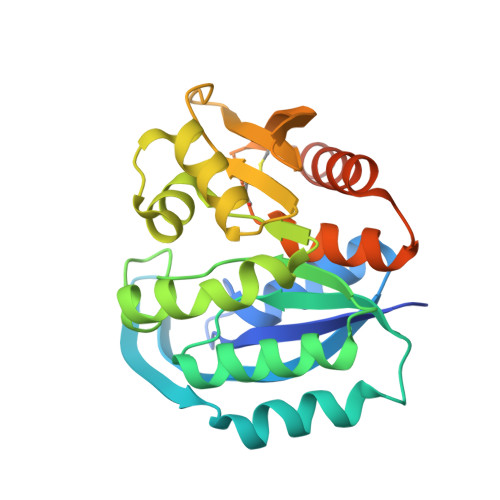Characterization of an Acinetobacter baumannii Monofunctional Phosphomethylpyrimidine Kinase That Is Inhibited by Pyridoxal Phosphate.
De Vitto, H., Belfon, K.K.J., Sharma, N., Toay, S., Abendroth, J., Dranow, D.M., Lukacs, C.M., Choi, R., Udell, H.S., Willis, S., Barrera, G., Beyer, O., Li, T.D., Hicks, K.A., Torelli, A.T., French, J.B.(2024) Biochemistry
- PubMed: 38306231
- DOI: https://doi.org/10.1021/acs.biochem.3c00640
- Primary Citation of Related Structures:
4YL5, 4YWR - PubMed Abstract:
Thiamin and its phosphate derivatives are ubiquitous molecules involved as essential cofactors in many cellular processes. The de novo biosynthesis of thiamin employs the parallel synthesis of 4-methyl-5-(2-hydroxyethyl)thiazole (THZ-P) and 4-amino-2-methyl-5(diphosphooxymethyl) pyrimidine (HMP) pyrophosphate (HMP-PP), which are coupled to generate thiamin phosphate. Most organisms that can biosynthesize thiamin employ a kinase (HMPK or ThiD) to generate HMP-PP. In nearly all cases, this enzyme is bifunctional and can also salvage free HMP, producing HMP-P, the monophosphate precursor of HMP-PP. Here we present high-resolution crystal structures of an HMPK from Acinetobacter baumannii (AbHMPK), both unliganded and with pyridoxal 5-phosphate (PLP) noncovalently bound. Despite the similarity between HMPK and pyridoxal kinase enzymes, our kinetics analysis indicates that AbHMPK accepts HMP exclusively as a substrate and cannot turn over pyridoxal, pyridoxamine, or pyridoxine nor does it display phosphatase activity. PLP does, however, act as a weak inhibitor of AbHMPK with an IC 50 of 768 μM. Surprisingly, unlike other HMPKs, AbHMPK catalyzes only the phosphorylation of HMP and does not generate the diphosphate HMP-PP. This suggests that an additional kinase is present in A. baumannii , or an alternative mechanism is in operation to complete the biosynthesis of thiamin.
- The Hormel Institute, University of Minnesota, Austin, Minnesota 55912, United States.
Organizational Affiliation:

















